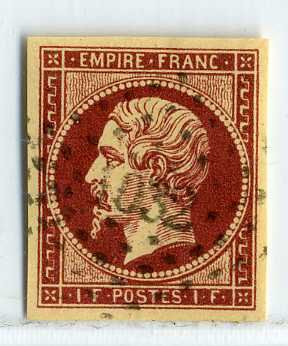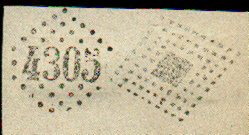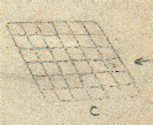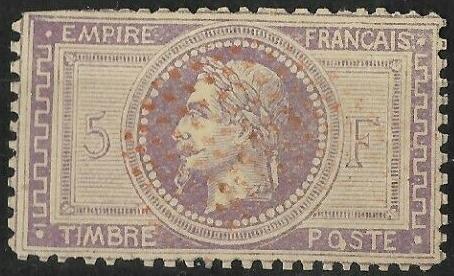 |
|||||
|
|||||
| Preview of Stamps Catalogue: VOLUME 1 |
 |
|||||
|
|||||
| Preview of Stamps Catalogue: VOLUME 1 |
Return To Catalogue - Napoleon III, Sperati forgeries - Napoleon III issues - France overview - Cancels on this issue
Note: on my website many of the
pictures can not be seen! They are of course present in the catalogue;
contact me if you want to purchase it.
Some primitive forgeries:
In the above forgery of the 25 c it can clearly be seen that the top part with 'REPUB FRANC' and the bottom part with the value, is attached to it. In this way, the forger could 'add in' the top and bottom part as desired without changing the central design. This forgery was recently offered on E-bay (as such). Note also that the lettering is different from the genuine stamp. Also note that the 'B' just below the head, typical for the 'REPUB FRANC' issue, is missing in the 10 c and 25 c. Next to it is a forgery of the 1 F of the next serie apparantly from the same forger (could this be Spiro?). The moustache is different from the genuine stamps in the above forgeries. I've seen these forgeries with part of a dot cancel with 'DS23' in the center.
In the above stamps a 25 c and 1 F of this
forgery is found printed together with a Ceres stamp of the same
value. This proves that these two stamps were made by the same
forger..
I've seen a whole sheet of 1 F forgeries, with on the left part
(3 columns of 9 stamps) the Napolean forgeries and on the right
(3 columns of 9 stamps as well) the Ceres stamps. The Napoleon
stamps had parts of a 'DS23' cancel and the Ceres stamps various
grill cancels applied to it on this sheet. Apparently these
cancels were printed on the sheet (since they appear often in the
same spot). I've also seen a sheet with forged 25 c Napoleon (3
columns of 9 stamps at the left) and Ceres stamps (3 columns of 9
stamps at the right) with the same cancels applied to it.
Another sheet shows 3x9 Napoleon 10 c stamps on the left and 3x9
Ceres 10 c stamps on the right, all in the color brown. These
were clearly made from the 1 F sheet, since the third stamp in
the fifth row (Napoleon, see image above) and the sixth stamp of
the bottom row (Ceres) did not have the 1 F changed to 10 c and
can thus be considered as misprints of the 1 F values in the
color brown instead of red.

Other primitive forgery of the 5 c.




Possibly a Fournier forgery, the cancel '1032' is known to have
been forged by Fournier. According to the Serrane guide the 4th
and 5th wavy line in the upper left corner are broken (as in the
first and second image). Later Fournier touched up these defects
(third image?).




Fournier forgeries taken from a 'Fournier Album of Philatelic
Forgeries'. According to the Serrane guide the wavy lines in the
upper left corner are broken.
Fournier has used forged cancels, examples of these forged cancels (taken from a Fournier Album):








Fournier has also used other forged cancels. Fournier used these cancels on his forgeries, but I don't know exactly on which issue he used which cancels. I do know that he used the '17 Star Cancel' on forged 5 F Napoleon stamps. Click here for more Fournier forgeries of France.

Deceptive Marseilles forgery (Faux de Marseille), image obtained
from Philippe Potel. The left "1" is slanting to the
left.

A tete-beche forgery of the 1 F value, made by an unknown forger

Block of four 1 c red forgeries, printed in reverse, together
with a forgery of the United States.
For Sperati forgeries of Napoleon stamps, click here.
Spiro forgery of this stamp:
The genuine stamps are always perforated nicely 13 1/2. This forgery (I believe this is the forgery described in 'The Spud Papers') is perforated very badly and is the easiest way to recognize it. The "5" and the "F" are printed afterwards in the genuine stamps and can therefore have a slightly different shade of colour from the rest of the stamp. In this forged stamp the "5", the "F" and the rest of the stamp have the same shade. The inscriptions of the forgery are too thick, aswell as the greek border and the dots in the corners are too large also. There is a cedilla below the "C" of "FRANCAIS" in the genuine stamps, but this is absent in this forgery (difficult too see in the above image). There are other small differences between the genuine stamp and this forgery.


(Left genuine, right forgery)





Image obtained thanks to Mark Toft. Next to it an image of the
"The illustrated catalogue of postage stamps" by
J.E.Gray (1870, page 199, see second image). In the Catalogue
Descriptif des Timbres-Poste crees de 1840 a 1870 by Arthur
Maury, a similar illlustration is given on page 54. This forgery
can also be found in the catalogue of Placido
Ramon de Torres "Album Illustrado para Sellos de
Correo" of 1879 (information passed to me thanks to Gerhard
Lang, 2016) on page 63 (third image). So either this forgery was
inspired by the de Torres catalogue, or de Torres copied an image
of a forgery into his catalogue. All these forgeries contain an
extra small line above the dot on the left hand bottom side. This
line does not appear in the genuine stamps. I've seen a printing
block of this forgery, apparently made by Pierre Mahé (signed by
Pierre at the back):


Front and back of a printing plate once belonging to Pierre Mahé
to print his albums. This printing plate corresponds to the above
forgery.
As in the previous forgery, the "5" and the "F" interrupt the horizontal lines with a white interior. Also note the weird shape of the letters "A" and "S" in the word "FRANCAIS" and other badly printed letters. There is also an extra horizontal line in the bottom left corner.





Another primitive forgery. The scrolls at the left and right hand
side go too far downwards. The "5" and "F"
are totally different from a genuine stamp. The cancel is
"PARIS 7E./1 JUIL. PL. DE LA BOURSE". I've seen this
forgery uncancelled as well. The last scan shows this forgery
pasted on a genuine letter, where the cancel on the envelope has
been 'matched' to the one on the forgery.
Some Fournier forgeries of the 5 F value:



Fournier forgeries with "BAR S-AUBE 2E/1 FEVR 71 (9)",
a "17" star cancel and a "VERSAILLES 2E/28 AVRIL.
71 (72)" cancel as they can be found in the Fournier Album.
This Fournier forgery was also used to illustrate Fournier's 1914 pricelist (also reprinted by Ragatz in 1947). Under 'Envois a choix' exactly this forgery is illustrated (without cancel). Note that the "C" of "FRANCAIS" does not have a cedilla, also note the strange "S" of this word. Fournier also seems to have sold this forgery as in the above example. Here it has a "BAR S-AUBE 2E/1 FEVR 71 (9)" cancel as can be found in 'The Fournier Album of Philatelic Forgeries'. The stamp itself can also be found in this album under 'Epreuve des cliches dont les timbres n'existent plus au stock'. The stamp next to it is also a Fournier forgery, now with a '17 Star Cancel'. Click here for more Fournier forgeries of France. I'm not sure if the Versailles cancelled forgery is a Fournier or a Peter Winter forgery.
Peter Winter forgeries:
The above forgery was made by Peter Winter (about 1980). I've only seen it with the cancels "VERSAILLES 2E/28 AVRIL. 71" and "LE LAC OU-VILLERS 1E/1 SEPT 25", but ther cancels might exist. This forgery is listed in the 'House of Stamps' catalogue. Winter might have based his forgery on an earlier forgery with cancel "VERSAILLES 2E/28 AVRIL. 71" which was already mentioned in The Serrane Guide.


And some other forgeries, the first one with exactly the same
cancel as the Winter forgery, made by the same forger? The design
of the stamps looks much more smudged though.


Possibly another Winter forgery with cancel "BEAUNE 3e 5
MARS (26)". I''ve also seen this forgery with the cancel
"BRINON - LES - ALLEMANDS 2E / 8 AOUT 76 (56)".

A block of Ceres forgeries with exactly the same cancel of
Beaune. I've also seen some 5 c green Ceres stamps with the same
cancels (also tete-beche and normal pairs).

Other modern forgery
The forger Sperati also seems to have made forgeries of the 5 F stamp (five varieties; among them three 'proofs'). They are not very common and quite valuable. FClick here for more information Sperati forgeries of Napoleon stamps.
Some 'tricked' genuine stamps are known to exist, for example a genuine 20 c imperforate Napoleon stamp, from which the "0" is erased carefully and then replaced by a cut out "5" from a 25 c Ceres stamp. It then appears to be a much rarer 25 c imperforate Napoleon stamp. (Source: Le Postillon, revue philatelique; March 1920, page 507). A similar trickery can be done to produce a rare 20 c 1849 non-issued Ceres stamp and replace the "5" by a "0" of a cheap 25 c Ceres stamp. I have not seen such a forgery yet.